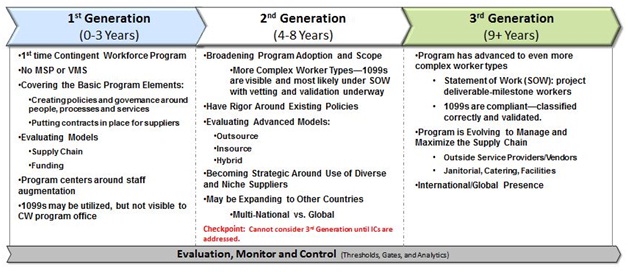 For every opinion there is on which generation across the maturity curve of utilizing non-employee labor your company is in today, what can be said with certainty is that there is no norm or standard. Ensuring that you keep the long-term health and growing needs of your organization at the forefront of your design and execution is critical. Before you declare yourself “there,” however, you’ll want to note a few foundational elements:
For every opinion there is on which generation across the maturity curve of utilizing non-employee labor your company is in today, what can be said with certainty is that there is no norm or standard. Ensuring that you keep the long-term health and growing needs of your organization at the forefront of your design and execution is critical. Before you declare yourself “there,” however, you’ll want to note a few foundational elements:
First, there are as many first-time managed contingent programs from a centralized, governed and policy-driven perspective across the Fortune 2000 as there are mature programs among the Global 100. There is no right or wrong program stage; truthfully assess where your program is in order to start developing a plan.
Second, despite a common theme of independent contractor usage throughout generations of programs across the maturity curve, where independents belong and most importantly, how independents should be factored into the talent strategy is ubiquitous. Because independent contractors are typically used throughout all generations of programs, this article will help you to explore how to best take advantage of these unique workers.
PREMIUM CONTENT: Savings-Based MSP Performance Incentives
Contingent Workforce Program Generations
Which program generation feels familiar? This is your current state (or your client’s if you are a provider) and gives you a starting point for developing your program goals.
First-Gen Contingent Workforce Programs:
- No managed service provider (MSP) or vendor management system (VMS).
- The basic program elements are in place, such as having visibility into a portion of your spend under management and basic controls over the suppliers in terms of contracts and minimum requirements to work with your company.
- You are contemplating, and possibly beginning to create policies and governance around people, processes and services for major hubs of contingent usage domestically.
- There’s an eye to the future, and therefore, you are evaluating various insourced and outsourced models types.
- Funding the program is mostly a 1:1 scenario.
- The program centers mostly around staff augmentation as opposed to SOW and Outsourced Services
- 1099s may not be in scope. A contributing factor tends to be that Information Technology spend is out of scope and therefore SOW is on the next horizon for you. Remember,most of your 1099s live there.
Second-Generation Contingent Workforce Programs:
- You are broadening the program adoption and scope by adding more complex worker types; in particular, the more expensive, long-term and specialized talent types who are on an SOW engagement. This SHOULD include 1099s and freelancers.
- You have rigor and substance supporting the existing policies which call out the worker definition types within your company for all talent types.
- Your benchmarking and evaluation of more advanced models is leading you to:
- Outsource
- Insource
- Or take a hybrid approach
- Your program is becoming strategic around the use of diverse and niche suppliers.
- Expanding to other countries is on your radar, if not your plan
Third-Generation Contingent Workforce Programs:
Please note: for the third-generation, you must have your ICs under control and compliant to consider your company ready for a third-generation-level program.
- The program has advanced to include even more complex worker types, including consultants. Your contingent workers are classed appropriately and re-classed to avoid risk and control costs, and independent contractors are properly vetted, validated and structured for optimal usage.
- Your program is evolving to manage and maximize the supply chain including:
- Outside Service Providers/Vendors
- Janitorial, Catering, Facilities
- You have an International/Global Presence. All global 20-type countries such as the U.K., Australia and India are in scope.
- You are contemplating the best approach and exploring how to implement necessary cultural, regulatory and localization for emerging markets.
The above is only a partial list of generational program aspects. Where are you now and where will you head? Don’t let default be your approach. Learn everything you can about designing a program that addresses your organization’s needs today and into the future. This will allow you to grow professionally within your organization and set your company up for long-term success by utilizing the most optimal talent pools and practices available, including the fastest growing population of nonemployees, the independents. Keep your eye to the horizon!
Join us next time when we uncover the top ten myths about contingent worker policy and classifications.










[…] For every opinion there is on which generation across the maturity curve of utilizing non-employee labor your company is in today, what can be said with certainty is that there is no norm or standard. […]
[…] Great article in Staffing Industry Analysts’ Staffing Stream by Dana Shaw, ICon’s Chief Operating Officer, exploring contingent workforce program generations and their attributes. Read “Contingent Workforce Program Generations: Are Independent Contractors In or Out?” to discover more about how companies can use the generational model to assess their current program and develop key future strategies. […]